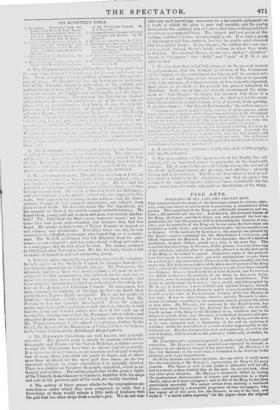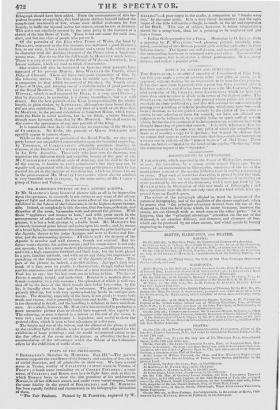FINE ARTS.
PORTRAITS OF THE LATE AND PRESENT KING.
Tnr. interest which the death of the Sovereign creates in society, natu- rally seeks one source of gratification in possessing a resemblance of his person. The engravings of the King are sufficiently numerous and ye- riot's ; the portraits are but few. Ithw BENCE, the favoured limner of the King, the Court, and the Cabinet, not only possessed the best op. portunities for, but the greatest skill in delineating the features of my.. alty ; and his portraits of the King are in one sense the !Pest—they are beautiful as works of art, and as resemblances also, but favourable even to flattery. Of the portraits by LAWRENCE, the popular one painted by the King's express command for the Marchioness CoNyminim, anti which represents the Monarch in his lest character, that of a finished gentleman, in plain doilies, seated on a sofa, is the most like. The beautiful line engraving, be IINDEN, Of this picture, is a very close copy of the original ; and this plate is generally allowed to be the hest 'print of the King as he wished to appear. Numerous copies of this portrait have been made in various sizes, and with modifications to give them an original air ; the mezzotint by TunNER IS the best, excepting the line engraving. The brilliant mezzotint of the whole-length picture:of the King in his robes of the Carter is more beautiful as a work of art than valuable as a likeness timerni the Fourth loved to be flattered, and Ltivimsce AV:IS skilful to flatter : the portraits of the King by this great artist, tberefore, must be regarded as ideal and favoured resemblunres. The sketch in profile made by LA witExcli for a medal, and lithographed by is, however, a more thithful and spirited likeness ; though favourable, it is mot co much flattered, and is a very beautiful drawing, as well as a line view of the handsome features of his late Majesty at that time. It was an after-dinner sketch ; aunt the Monarch is repre- sented in armour, nceording to the command jocosely given to the artist at that time. Mr. WILKIE, his successor in the Royal favour, has either been more honest, or has flattered less skilfully : for his full- length picture of the King in the Highland dress whatever may be its defects as a work of art, has the merit of indivapal character and per- sonal resemblance beyond any other. There is the King and the man as he was, excepting only a diminution of fat and an omission of wrinkles, which the atmosphere of a court renders imperceptible to the initiated eye. But the characteristic look and expression, as well as the cast raovf efdea. tare, will be found in this portrait ; which will, doubtless, be engraved.
Mr. NOR TITCOTE'S equestrian portrait is unlike both in feature and expression. Mr. Hor.mEs's head, painted anti engraved by himself, is a failure, in our opinion ; though it has some merit. Mr. WI vEf. f.'s is like, but flattered ; at the same time, it is stunted in the drawing, looks plethoric, and is not characteristic.
Of all the sketches and minor portraits, the one which is really most like the individual, is Mr. Dovt.E's, representing the King in his pony phaeton. The figure as well as the profile is admirably well hit off; and it conveys a more faithful idea of the man, his air and look, than any other print whatever. Mr. DOYLE is eminently skilful in seizing the predominant characteristics of feature and expression in a slight sketch, taken as it were extempore ; and in this of the King he has been particularly successful. We cannot refrain from noticing a barefaced piracy, committed by a monopolist proprietor of four newspapers, who has copied all of this print but the likeness, in two of the four, and styles it "a sketch taken expressly" for his paper—from the original
lithograph should have been added. From the consequences of this im- pudent invasion of copyright, this bold pirate shelters himself behind the complicated machinery of law, whose most skilful craftsmen he fees largely, to baffle the injured seeker for redress, whom he sets at defiance. This artist was similarly treated by the same party in the instance of a Sketch of the late Duke of York. There is but one name for such con- duct, and but one class of people who pursue it.
Of the portraits of the King when Prince of Wales, the head by Punn.IPS, engraved in the line manner, was reckoned a good likeness ; but, to our view, it has a dowdy character and a smug look, which is not in character with the dashing elegance of the Prince when a handsome young man. Nor do we like the full-length by Hoer NrElt much better. There is a very sit tt-v picture of the Prince of Wales on horseback, in a hussar uniform, •>>. hich we used to think characteristic.
Our readers will also be interested in knowing what portraits have appeared of his pre:ent Majesty, King WIL1,I:x:1u the Fourth, when Duke of Clarence. There are three very good engravings of him, by the following artists. The first, when in middle age, by PHI T.I. rps ; a companion to that which we noticed of licoituc the Fourth when Prince of Wales, and forming one of a unitnrm series of good portraits of the Royal Brothers. The two lust are of recent date : the one by Wry ELL, which is well engraved by Ho LL, is a very good likeness ; that by JAG OE Rs, in mezzotint, is a strong resemblance, but not well drawn. But the best portrait of the King is unquestionably the whole- length, in plain clothes, by LAwitExcE, although we have heard that it did not give satisfaction. It is not only finer as a work of art than that by MORTON, in the present exhibition at Somerset House, which repre- sents the Duke in naval uniform, but is, we think, a better likeness, though more favoured, than that by Mr. MoirroN. We shall notice in due course the appearance of alty new portrait if the King.
It is remarkable that there should exist no engraving of the Duchess O f CLARENCE. Ni) doubt, the portrait of Queen AnuLAIDE will speed i Iy appear in various sl ewes.
While on the subject of portraits of the Royal Family, we may pro- perly bestow our unqualified CI nnmendation upoil the bealitiful engraving, by THOMSON, of CAR II ONN MU'S :id inirable miniature drawing, in crayons, of the Duthess of Cu:ut nEnLAN n, published (or to be published) in La Belle Assemblee. Thi u mily who have seen the drawing, can appreciate the elaborate finish raid exquisite beauty of this gem of art.
CARRONNIEIt's excellent style of drawing, and his skill in the use of the crayon, is known to uvory o muoisseur ; but thee may not be equally well acquainted with the delicacy :end perfeetbei to which he has carried his art in the instance of this drawing, which we chanced to see In the print-room of Mr. MART'S Co LNAGIt ; \di:Tv :List) xvt, admired a, very beautiful work in crayons, by the same artist, of Mr. CARE w's group of Venus and Vulcan.



























 Previous page
Previous page